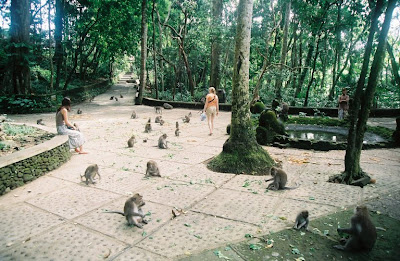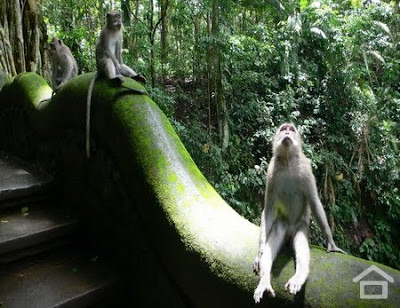CULTURAL SIGNIFICANCE Within Balinese Hinduism, monkeys can be the embodiment of both positive and negative forces. The dual nature of monkeys is especially reflected in the Ramayana (a very popular Indian epic poem). Within the Ramayana, Sita (the beloved bride of Rama) is abducted by Rawana (an evil king). Rama (an incarnation of Dewa Wisnu) calls upon Sugriwa (king of the monkeys) and Hanuman (Sugriwa's General) to help him retrieve Sita. However, within the Ramayana, there are also antagonist monkeys like Subali that attempt to assist Rawana. In the end, Hanuman, along with his monkey army, defeats Rawana's evil forces and helps Rama to retrieve Sita. Within Balinese Hinduism, monkeys can be the embodiment of both positive and negative forces. The dual nature of monkeys is especially reflected in the Ramayana (a very popular Indian epic poem). Within the Ramayana, Sita (the beloved bride of Rama) is abducted by Rawana (an evil king). Rama (an incarnation of Dewa Wisnu) calls upon Sugriwa (king of the monkeys) and Hanuman (Sugriwa's General) to help him retrieve Sita. However, within the Ramayana, there are also antagonist monkeys like Subali that attempt to assist Rawana. In the end, Hanuman, along with his monkey army, defeats Rawana's evil forces and helps Rama to retrieve Sita.Because monkeys can embody both positive and negative forces, the Balinese both loathe and revere monkeys. Monkeys that occupy sacred Balinese Hindu temple sites (like the Sacred Monkey Forest) tend to be revered and protected by the Balinese. One reason for this is that monkeys, in the form of a Barong, are believed to be capable of guarding temple sites against evil spirits (for additional discussion on Barongs, see the chapter titled "GODS, GODDESSES, AND DEMONS"). However, the Balinese belief that monkeys can be negative in nature is reinforced when, for example, they raid rice fields or snatch items from souvenier shops. MACAQUE FAMILIES  Adult male and female Balinese long-tailed macaques have distinguishable physical characteristics. Males tend to be larger then females. Male Balinese long-tailed macaqes can weigh up to 10 kilograms (approximately 18 pounds). Males, in comparison to females, have broader shoulders and larger canine teeth. In addition, females have facial hair that resembles a 'bear' whereas males have more pronounced 'mustaches'. Adult male and female Balinese long-tailed macaques have distinguishable physical characteristics. Males tend to be larger then females. Male Balinese long-tailed macaqes can weigh up to 10 kilograms (approximately 18 pounds). Males, in comparison to females, have broader shoulders and larger canine teeth. In addition, females have facial hair that resembles a 'bear' whereas males have more pronounced 'mustaches'.Compared with adult males, sub-adult males have smaller bodies, smaller canine teeth, shorter back/shoulder hair and narrower shoulders. Compared with adult females, sub-adult females typically have shorter nipples. This is because female macaques do not reach adult status until after they have given birth. Accommodation hotels in ubud gianyar bali, booking online ubud hotels Young macaques are split into 3 age groups. Young macaques that are between the age of 0-6 months old and have predominantly black hair color are called 'Infant 1'. Young macaques that are between the age of 6-12 months old and have black hair only on their head are called 'Infant 2'. Finally, young macaques that are between 1-3.5 years in age are called 'Juveniles'. Mother macaques can be very protective and tourists should always be cautious when approaching infant macaques. |
The Monkey Forest
Subscribe to:
Post Comments (Atom)

No comments:
Post a Comment